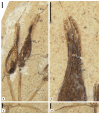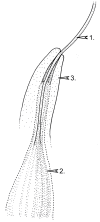A new early Cretaceous relative of Gnetales: Siphonospermum simplex gen. et sp. nov. from the Yixian formation of northeast China
- PMID: 20565755
- PMCID: PMC2900273
- DOI: 10.1186/1471-2148-10-183
A new early Cretaceous relative of Gnetales: Siphonospermum simplex gen. et sp. nov. from the Yixian formation of northeast China
Abstract
Background: Knowledge on fossil and evolutionary history of the Gnetales has expanded rapidly; Ephedra and ephedroids as well as the Gnetum-Welwitschia clade are now well documented in the Early Cretaceous. However, hypotheses on evolutionary relationships among living and fossil species are hampered by restricted knowledge of morphological variation in living groups and recent studies indicate that gnetalean diversity and character evolution may be more complex than previously assumed and involve additional extinct groups (Bennettitales, Erdtmanithecales and unassigned fossil taxa).
Results: Here we describe a new fossil related to Gnetales, Siphonospermum simplex from the Early Cretaceous Yixian Formation, an impression/compression of a reproductive shoot. The slender main axis bears one pair of opposite and linear leaves with primary parallel venation. The reproductive units are ovoid, without supporting bracts and borne on one median and two lateral branches. The most conspicuous feature of the fossil is the long, thread-like micropylar tube formed by the integument. Each ovule is surrounded by two different layers representing one or two seed envelopes; an inner sclerenchymatous layer and an outer probably parenchymatous layer.
Conclusions: The vegetative and reproductive features of Siphonospermum simplex exclude a relationship to any other group than the Gnetales. A combination of opposite phyllotaxis, linear leaves and ovules surrounded by seed envelope(s) and with a long exposed micropylar tube are known only for extant and extinct Gnetales. Siphonospermum simplex constitutes a new lineage within the Gnetales. Its morphology cannot be directly linked to any previously known plant, but the organization of the reproductive units indicates that it belongs to the Gnetum-Welwitschia clade. Based on the absence of cone bracts and the inferred histology of the seed envelope(s) it could be related to Gnetum, however, there are also affinities with the ephedran lineage, some of which are likely plesiomorphic features, others perhaps not. Phylogeny and character evolution in the Bennettitales, Erdtmanithecales and Gnetales are currently only partly understood and under debate; the exact systematic position of Siphonospermum simplex, i.e., its position within the Gnetales, cannot be resolved with certainty.
Figures



Similar articles
-
Chengia laxispicata gen. et sp. nov., a new ephedroid plant from the Early Cretaceous Yixian Formation of western Liaoning, Northeast China: evolutionary, taxonomic, and biogeographic implications.BMC Evol Biol. 2013 Mar 27;13:72. doi: 10.1186/1471-2148-13-72. BMC Evol Biol. 2013. PMID: 23530702 Free PMC article.
-
Former diversity of Ephedra (Gnetales): evidence from Early Cretaceous seeds from Portugal and North America.Ann Bot. 2006 Jul;98(1):123-40. doi: 10.1093/aob/mcl078. Epub 2006 May 4. Ann Bot. 2006. PMID: 16675607 Free PMC article.
-
Cratonia cotyledon gen. et sp. nov: a unique Cretaceous seedling related to Welwitschia.Proc Biol Sci. 2003 Aug 7;270 Suppl 1(Suppl 1):S29-32. doi: 10.1098/rsbl.2003.0044. Proc Biol Sci. 2003. PMID: 12952628 Free PMC article.
-
Leaf surface development and the plant fossil record: stomatal patterning in Bennettitales.Biol Rev Camb Philos Soc. 2019 Jun;94(3):1179-1194. doi: 10.1111/brv.12497. Epub 2019 Feb 4. Biol Rev Camb Philos Soc. 2019. PMID: 30714286 Review.
-
Evolution and patterning of the ovule in seed plants.Biol Rev Camb Philos Soc. 2021 Jun;96(3):943-960. doi: 10.1111/brv.12684. Epub 2021 Jan 11. Biol Rev Camb Philos Soc. 2021. PMID: 33432779 Review.
Cited by
-
The earliest fleshy cone of Ephedra from the early cretaceous Yixian Formation of northeast China.PLoS One. 2013;8(1):e53652. doi: 10.1371/journal.pone.0053652. Epub 2013 Jan 14. PLoS One. 2013. PMID: 23341964 Free PMC article.
-
A Review on Worldwide Ephedra History and Story: From Fossils to Natural Products Mass Spectroscopy Characterization and Biopharmacotherapy Potential.Evid Based Complement Alternat Med. 2020 Apr 30;2020:1540638. doi: 10.1155/2020/1540638. eCollection 2020. Evid Based Complement Alternat Med. 2020. PMID: 32419789 Free PMC article. Review.
-
Past aridity and dust drove biodiversity crises and altered pollination in the ancient gymnosperm Ephedra (Gnetales).Biol Rev Camb Philos Soc. 2025 Aug;100(4):1680-1697. doi: 10.1111/brv.70019. Epub 2025 Apr 7. Biol Rev Camb Philos Soc. 2025. PMID: 40194865 Free PMC article. Review.
-
A new macrofossil ephedroid plant with unusual bract morphology from the Lower Cretaceous Jiufotang Formation of northeastern China.BMC Evol Biol. 2020 Feb 4;20(1):19. doi: 10.1186/s12862-019-1569-y. BMC Evol Biol. 2020. PMID: 32019502 Free PMC article.
-
A new gnetalean macrofossil from the Lower Cretaceous of the Laiyang Basin, eastern China.Plant Divers. 2024 Mar 14;46(5):678-682. doi: 10.1016/j.pld.2024.03.002. eCollection 2024 Sep. Plant Divers. 2024. PMID: 39290879 Free PMC article.
References
-
- Kubitzki K. Vol I. Pteridophytes and Gymnosperms. Berlin: Springer; 1990. The families and genera of vascular plants.
-
- Arber EAN, Parkin J. Studies on the evolution of angiosperms: the relationship of the angiosperms to the Gnetales. Ann Bot. 1908;22:489–515.
-
- Krassilov VA. Early Cretaceous flora of Mongolia. Palaeontographica B. 1982;181(1-3):1–43.
-
- Crane PR, Upchurch GR. Drewria potomacensis gen. et sp. nov., an Early Cretaceous member of Gnetales from the Potomac Group of Virginia. Am J Bot. 1987;74:1722–1736. doi: 10.2307/2444143. - DOI
-
- Duan S. The oldest angiosperm - a tricarpous female reproductive fossil from western Liaoning Province, NE China. Sci China Ser D. 1998;41(1):14–20. doi: 10.1007/BF02932415. - DOI
Publication types
MeSH terms
LinkOut - more resources
Full Text Sources

